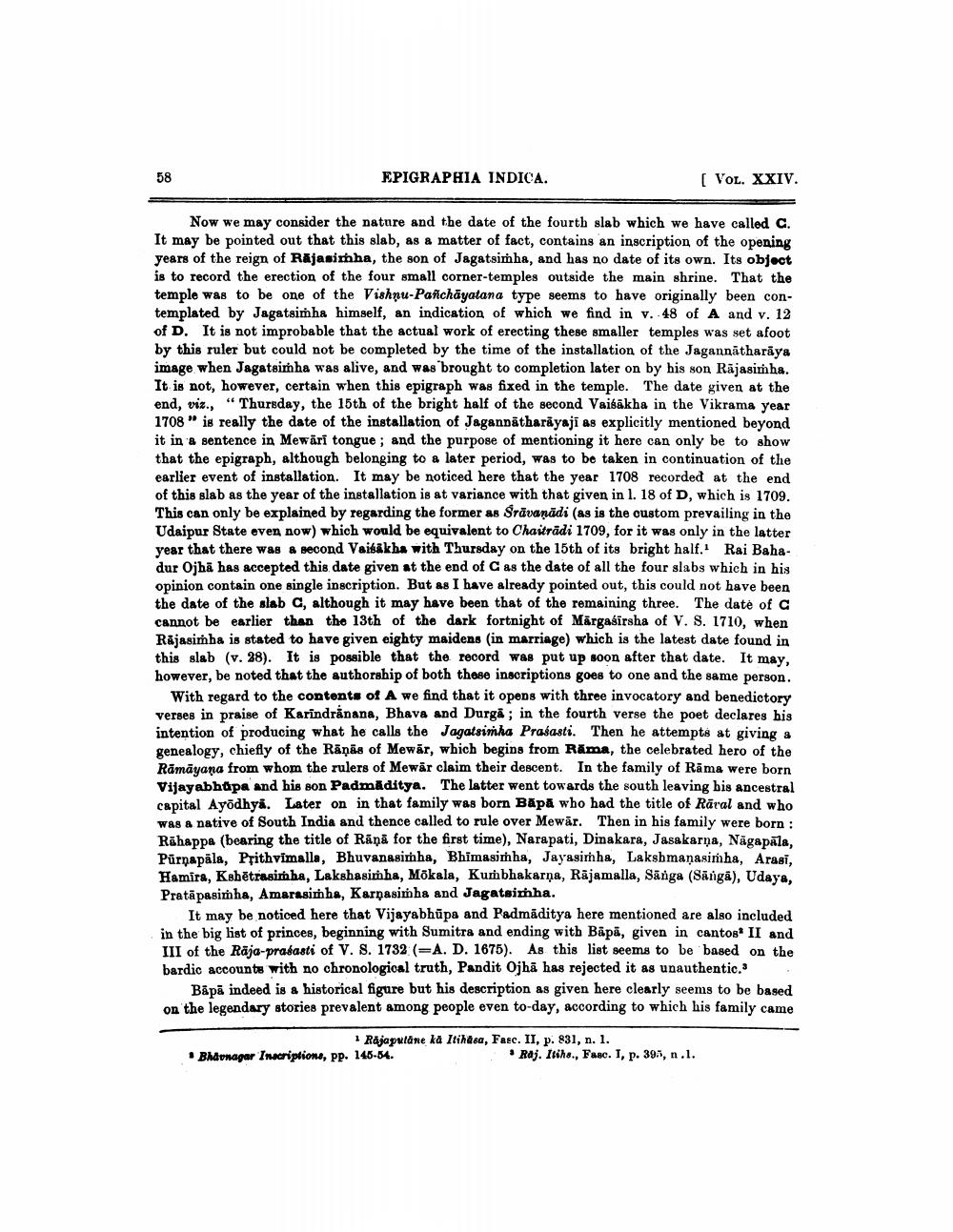________________
EPIGRAPHIA INDICA.
( VOL. XXIV.
Now we may consider the nature and the date of the fourth slab which we have called C. It may be pointed out that this slab, as a matter of fact, contains an inscription of the opening years of the reign of Rajasimha, the son of Jagatsimha, and has no date of its own. Its object is to record the erection of the four small corner-temples outside the main shrine. That the temple was to be one of the Vishnu-Panchayatana type seems to have originally been contemplated by Jagatsimha himself, an indication of which we find in v. 48 of A and v. 12 of D. It is not improbable that the actual work of erecting these smaller temples was set afoot by this ruler but could not be completed by the time of the installation of the Jagannātharaya image when Jagatsimha was alive, and was brought to completion later on by his son Rājasimha. It is not, however, certain when this epigraph was fixed in the temple. The date given at the end, viz., “Thursday, the 15th of the bright half of the second Vaisakha in the Vikrama year 1708" is really the date of the installation of Jagannatharāyaji as explicitly mentioned beyond it in a sentence in Mewari tongue; and the purpose of mentioning it here can only be to show that the epigraph, although belonging to a later period, was to be taken in continuation of the earlier event of installation. It may be noticed here that the year 1708 recorded at the end of this slab as the year of the installation is at variance with that given in l. 18 of D, which is 1709. This can only be explained by regarding the former as Srāvanādi (as is the custom prevailing in the Udaipur State even now) which would be equivalent to Chaitrādi 1709, for it was only in the latter year that there was a second Vaisakha with Thursday on the 15th of its bright half.! Rai Bahadur Ojbā has accepted this date given at the end of C as the date of all the four slabs which in his opinion contain one single inscription. But as I have already pointed out, this could not have been the date of the slab C, although it may have been that of the remaining three. The date of C cannot be earlier than the 13th of the dark fortnight of Märgaśīrsha of V. S. 1710, when Rajasimha is stated to have given eighty maidens (in marriage) which is the latest date found in this slab (v. 38). It is possible that the record was put up soon after that date. It may, however, be noted that the authorship of both these inscriptions goes to one and the same person.
With regard to the contents of A we find that it opens with three invocatory and benedictory verses in praise of Karindranana, Bhava and Durgā; in the fourth verse the poet declares his intention of producing what he calls the Jagatsimha Prasasti. Then he attempts at giving a genealogy, chiefly of the Rāņās of Mewar, which begins from Rāma, the celebrated hero of the Rāmāyana from whom the rulers of Mewar claim their descent. In the family of Rāma were born Vijayabhupa and his son Padmaditya. The latter went towards the south leaving his ancestral capital Ayodhya. Later on in that family was born Bāpā who had the title of Rāral and who was a native of South India and thence called to rule over Mewar. Then in his family were born: Rāhappa (bearing the title of Rāņā for the first time), Narapati, Dinakara, Jasakarņa, Nāgapala, Pūrnapāla, Prithvimalla, Bhuvanasimha, Bhimasimha, Jayasimha, Lakshmaṇasimha, Arasi, Hamira, Kshētrasimha, Lakshasimha, Mökala, Kumbhakarņa, Rajamalla, Sanga (Sanga), Udaya, Pratäpasimha, Amarasimhe, Karnasimha and Jagatsinha.
It may be noticed here that Vijayabhūpa and Padmāditya here mentioned are also included in the big list of princes, beginning with Sumitra and ending with Bāpā, given in cantos II and III of the Räja-prasasti of V. S. 1732 (=A. D. 1675). As this list seems to be based on the bardic accounts with no chronological truth, Pandit Ojhā has rejected it as unauthentic. .
Bāpā indeed is a historical figure but his description as given here clearly seems to be based on the legendary stories prevalent among people even to-day, according to which his family came
Bhavnagar Inscriptione, pp. 146-54.
Rajapulāne ka Itihasa, Faec. II, p. 831, n. 1.
Raj. Itihs., Fasc. I, p. 397, n.l.




